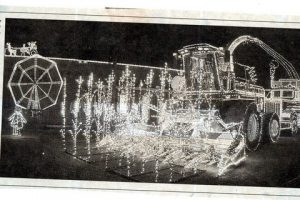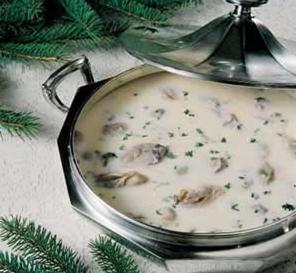Christmas Traditions on the Farm: The Christmas We Dressed the Chickens
Originally posted on December 22, 2010, by Arizona Farm Bureau’s Fill Your Plate
By Pennee Murphree, former Arizona cotton, wheat and alfalfa farmer
My aunt and uncle moved from an Iowa farm to a farm in Missouri to raise chickens in the 1950s. We happily drove from Iowa to spend Christmas with them and see the new farm. What a surprise awaited us. 
It was the Christmas that we dressed chickens all day. No, we did not put pants and a hat on them. We had to dress them for the freezer.
It seems that the electricity went off in the chicken house and the warming lights were not on. The weather turned extremely cold, so the chickens huddled together in a corner of the chicken house to keep warm and hundreds of them smothered.
The prudent thing to do was to get them into the freezer fast so, off with their heads. I do not remember how many chickens were prepared for the freezer that day but believe me it was a long day and there were feathers everywhere. Everyone took turns at the job in the barn and the job in the house. I preferred stirring the gravy in the house to plucking the chickens in the barn.
The reality of farm life is pretty grim at times, but everyone pitched in to save the day for my aunt and uncle. At least we were all together and the story has been told at every Christmas since. We always have a good laugh about “The Christmas we dressed the chickens.”
Christmas Traditions on the Farm: Daddy Hooks Up the Sled to the Tractor
Originally posted on December 17, 2010, by Arizona Farm Bureau’s Fill Your Plate
By Pennee Murphree, former Arizona cotton, wheat and alfalfa farmer
Visiting my grandparents in Gilbert, Iowa, was always fun, but Christmas Day was exciting. Dinner would be cooking on a wood stove when we and my aunts, uncles, and cousins arrived. Grandma was a great cook so with Mom, Auntie Donna, Auntie Fritz, and Auntie Berneta chipping in to help, dinner was soon on the table. It was always a sit-down dinner around the dining room table where another stove warmed the room as well as a simple prayer of thanks to our Lord. 
Gifts were simple and often homemade, and never opened until we all pitched in to clean up the dinner dishes. Then we would gather in the living room, usually curtained off with quilts for the winter, but opened on Christmas Day. Under the simple Christmas tree in my child-like eyes were what seemed like hundreds of gifts. The same tie that got passed around every year and went from family to family, matching bath robes for me and the two cousins my age made by my Aunt Donna, a can of tobacco for my great grandfather, Grandpa Ross, and homemade doll clothes for last year’s doll. An orange, homemade cookies, popcorn balls and peppermint candy were favorites too, but the laughs, the jokes and the hugs of thanks were the best.
And eventually, we all made it out to play in the snow, building a snow fort or throwing snowballs. Sometimes my dad would hook up a sled to the back of a tractor and pull us around until it was too cold to continue. I think we were poor, but I didn’t know it.
Christmas Traditions on the Farm: Mrs. Claus’ Christmas Spirit is as Strong as Santa’s!
Originally posted on December 16, 2010, by Fill Your Plate
By Julie Murphree, Arizona Farm Bureau Outreach Director
Who says Santa has a lock on the Christmas Spirit? I’m thinking Mrs. Claus really rouses the spirits of everyone around the North Pole. With her cookies and other baking, how could it not!? And, of note, love Jolly ole’ Saint Nick but his tubby tummy is not poor food choices, it’s just good home cooking in mass quantities (I know, he told me so; I told him it’s all about portions). 
Mrs. Claus’ Christmas joy must be extending all over the world because I’m getting so many stories about the women gathering to bake or cook for Christmas. Here are two.
Sandy Silvas of Silvas Farms has a big family gathering to bake. “Our tradition involves all the ladies and grandkids gathering at Grandma’s house to make cookies and fudge to give out as gifts to people in our lives,” she explains. “We, of course, have the men around to be taste testers and the kids also help. It is an all-day event, and everyone enjoys the time together.”
Silvas Farms is a small u-pick farm south of Yuma that provides Tangaloes, blackberries and peaches.
So that was Mrs. Claus’ strategy with the baking: Get the family to gather around. Good cooking always does.
And, here in the southwest, we have a twist to that. We make tamales. I love tamales!
Rhonda Crow of Crow’s Dairy does the all-day tamale-making over the holidays. “All of the ladies in our family get together every year on the first Saturday of December and make tamales,” she says. “This year we made 60 dozen!”
The Stechnij,’s owners of Superstition Farms makes tamales too. Here’s how Glenda tells the story:
“We make Christmas tamales the weeks before the holiday. For many years the family has gotten together with an assembly line to make them. One person oversees cleaning husks, one spreads the masa (that is my job!), and another adds the meat; usually, a younger member is in charge of hiding the olive and then someone rolls and wraps. The tamales are rushed to the freezer to keep from spoiling.
Many years ago, my mother-in-law set the rules that the tamales not be eaten until Christmas morning because she said that it was bad luck. Later I realized that she had to say that because with a family of seven kids, she had to set those rules to assure there were still some for December 25th!!
The entire family and friends would always meet for breakfast on Christmas morning for fresh tamales. Hector, my husband, teasingly would say, “If it wasn’t for the tamales, I wouldn’t have anything to unwrap Christmas morning!”
Crow’s Dairy makes Arizona Farmstead goat cheese.
Ronda and Sandy, and Glenda, I’m coming over!
Christmas Traditions on the Farm: Reindeer Layover
By Julie Murphree, Arizona Farm Bureau Outreach Director
Originally posted on December 15, 2010, by Arizona Farm Bureau’s Fill Your Plate
Have you heard about the Reindeer Layovers? Santa has mapped out all the ranches providing hay and grain for the reindeer. Yes, in fact, it’s become a familiar route for him.

Santa’s reindeer need pit stops on Christmas Eve (photo credit: BIgStockPhoto.com)
For the ranches that put out feed (grain and hay) for the reindeer, Santa will make a pitstop since he’s got presents to put around the ranch families’ Christmas trees anyway.
The proof comes in the morning when the children head out to where they put the feed out to always discover that it’s all gone.
Christmas Traditions on the Farm: One Ranch Family Delights in the Children’s Excitement
Originally posted on December 13, 2010, by Arizona Farm Bureau’s Fill Your Plate
By Julie Murphree, Arizona Farm Bureau Outreach Director
The Arizona ranching couple diversify to help make Their historic family ranching operation profitable. That means ventures like Agri-tourism (overnight guest house) as well as new product lines that include mesquite wood. Their century-old cattle ranch, the Carlink Ranch, is core to the operation and where most of their ranching traditions come from. 
But the newest traditions involve the Christmas traditions they’ve started with their two children, Hannah and Johnny. “For us, they’re really basic,” says Stefanie. “We’ve started to prepare a pork and green chili stew on Christmas Eve, simply because it’s fast and easy. We find that our cooking endeavors must be that way to keep up with the work on the ranch.”
They also cut a fresh Christmas tree every year. “We have to go off the ranch to do this unless we want to start decorating a mesquite tree instead of an evergreen,” she laughs.
Like every family, Christmas is so much about the children. “I love watching the kids enjoy Christmas,” says Stefanie. “They get so excited about every little thing that relates to Christmas. So, we try to make the experience as special as possible.”
Christmas Traditions on the Farm: Oyster Stew on Christmas Eve
Originally posted on December 10, 2010, by Arizona Farm Bureau’s Fill Your Plate
By Julie Murphree, Arizona Farm Bureau Outreach Director
Ever since I can remember, Mom made oyster stew on Christmas Eve. As adults, we still ask Mom to do her oyster stew if we’re coming over on Christmas Eve. We usually will have a bowl of soup before or after heading to Christmas Eve Service. 
So, where did the tradition start? We’re still piecing that together. But it turns out the tradition is common in more than one culture.
According to some, Irish immigrants who had fled to America during the potato famine in the mid-1800s began the tradition since they were accustomed to a Christmas Eve stew containing ling fish, which wasn’t available here.
The reason for a seafood dish on Christmas Eve was that eating meat the day before a religious feast, like Christmas, was forbidden by the Catholic Church.
In Italy, fish soup, “zuppa di pesce,” was likewise consumed. In some homes in Mexico, oyster stew (“estofado de ostras”) also came to be a dish served on Christmas Eve.
So, the experts conclude that the tradition of fish or oyster stew on Christmas Eve spread to other cultures beyond the Irish and Catholic traditions.
But Mom tells a story of her Grandpa Ward bringing home an entire bucket for Grandma Ward to cook in a stew. And they lived in land-locked Iowa. Well, there may be an explanation for that too.
In Bill Neal’s Southern Cooking (1989), Neal writes, “Before acceptance of refrigerated food transport (for meat only, first, and that was in the 1880s), inland food supplies depended on the weather. Even after the first frost warm spells threatened the integrity of almost any product, especially seafood. Only December, though the fourth ‘R’ month, guaranteed enough sustained cold weather for shipping. Then, from Baltimore to Charleston, to New Orleans, oysters were shoveled onto the flat backs of horse-drawn wagons and packed down in wet straw and seaweed for an inland journey sometimes lasting two weeks or more. Far from the coast, oysters became a symbol of the arrival of the winter holiday season, appearing in the markets by Christmas Eve and on the tables that night as oyster stew.”
So, there you have it. Grandpa Ward’s bucket of fresh oysters signaled to the family that winter was official, and it was time to cook something that warmed the soul and celebrated Christmas.
I just love Christmas.
The Family Recipe for Oyster Stew
Ingredients
- 1/2 cup butter
- 1 cup minced celery
- 3 tablespoons minced shallots
- 1-quart half-and-half cream
- 2 (12 ounces) containers freshly shucked oysters, undrained
- Salt and ground black pepper to taste
- 1 pinch cayenne pepper, or to taste
Directions
Melt the butter in a large skillet over medium heat and cook the celery and shallots until the shallots are tender.
Pour half-and-half into a large pot over medium-high heat. Mix in the butter, celery, and shallot mixture. Stir continuously. When the mixture is almost boiling, pour the oysters and their liquid into the pot.
Season with salt, pepper, and cayenne pepper. Stir continuously until the oysters curl at the ends.
When the oysters curl the stew is finished cooking; turn off the heat and serve.
This recipe, along with others, is also available on Fill Your Plate. The recipes on Fill Your Plate are mostly from our Arizona farmers and ranchers.

